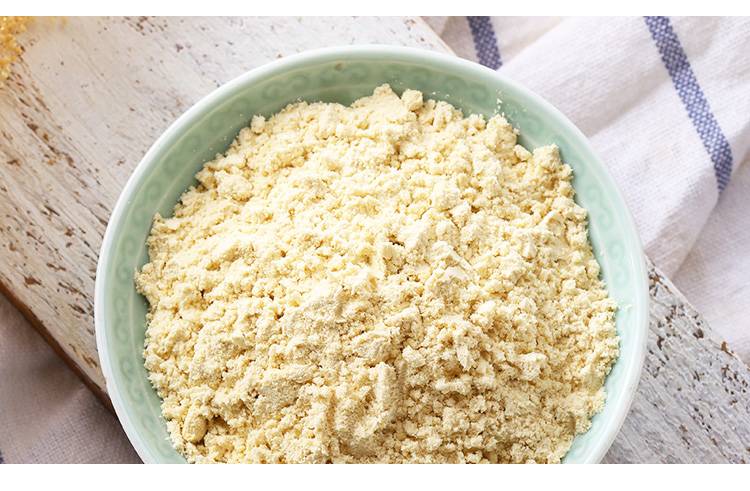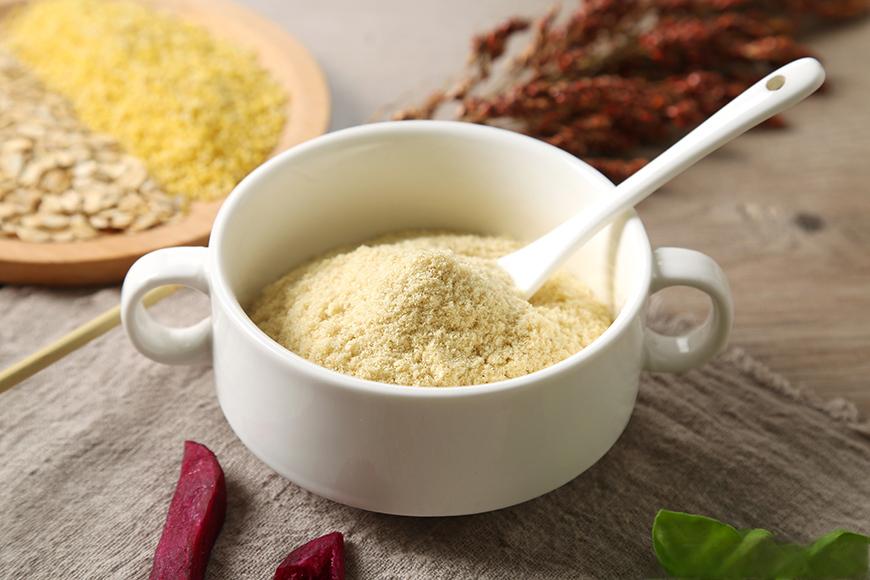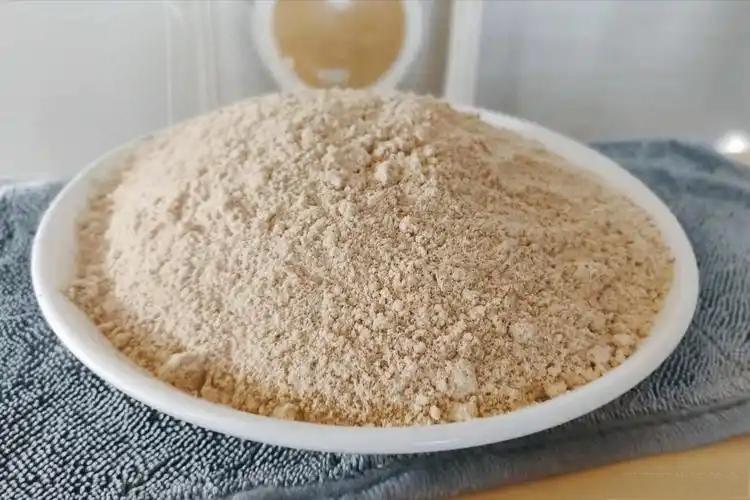What Is Soy Protein Powder?
Soybeans are one of China's main crops. They contain 18% to 22% oil and about 40% protein, and relatively little carbohydrate, about 20% to 30%. They therefore have the characteristics of both an edible oil and an edible protein source, and are highly nutritious. In 1999, the US Food and Drug Administration (FDA) issued a statement: daily consumption of 25 g of soy protein can reduce the risk of heart disease risk [1-3]. The main source of soy protein is low-temperature defatted soybean meal, which is recommended as a substitute for high-fat animal diets because it is a complete protein source that can lower cholesterol [4]. Therefore, in-depth research on the structure and function of soy protein can lay a practical foundation for the full utilization of soy protein and provide a theoretical basis for the development of new healthy protein nutrition products.
1 Overview of soy protein
Soy protein is the highest quality vegetable protein and the highest quality protein source in the diet of the population. In December 2019, the US Food and Drug Administration (FDA) approved soy hemoglobin as a coloring agent and certified it as safe [5]. Soy protein can be divided into soy flour, soy protein concentrate and soy protein isolate according to its protein content. Soy protein isolate has a protein content of up to 90% and is the soy protein with the highest nutritional value [6].
Zhang Cuifang [7] studied the application of soy protein isolate in bread and found that adding soy protein isolate to bread can improve its nutritional value. An analysis of the aging of bread with added soy protein isolate also found that the addition of soy protein isolate slows the aging of bread.
2 Preparation methods for soy protein
Effective methods are used to break the cells in the soybean tissue and dissolve the protein in it, and then the soybean protein is separated from other impurities using the differences between the soybean protein and other components. Common methods of extracting soybean protein include the alkali-solubilization-acid-precipitation method, the enzyme extraction method, and the ethanol extraction method.
2.1 Alkali-solubilization-acid-precipitation method
The alkaline acid precipitation method involves dissolving the protein in the soybeans in an alkaline environment, and then precipitating it out of the solution in an acidic environment at the isoelectric point. The alkaline acid precipitation method is widely used in protein extraction because of its advantages of being simple to operate, low cost, high extraction efficiency and high purity. The disadvantage is that the protein will undergo a Maillard reaction in an extremely alkaline environment, which affects its functional properties [8].
Lu Yang et al. [9] prepared soy protein isolate from low-temperature defatted protein by the alkaline solubilization and acid precipitation method, and concluded that the optimal process conditions for extracting soy protein isolate were a liquid-to-liquid ratio of 1:10, a temperature of 50 °C, and a pH of 9.0, which yielded an extraction rate of up to 79.01% for soy protein. Liu Dong [10], et al. used the alkali-soluble acid precipitation method to extract soy protein isolate from fermented soybean meal and determined the optimal process: alkali-soluble pH 9.4, alkali-soluble time 56 min, alkali-soluble temperature 41 °C, and material-to-liquid ratio 1:12. The protein extraction rate can reach 60.36%. At the same time, the solubility of the protein, in vitro digestibility and acid-soluble protein content of defatted soybean meal after fermentation are significantly higher than those of unfermented soybean meal. This proves the feasibility of the alkaline solubilization and acid precipitation method for extracting protein from fermented soybean meal.
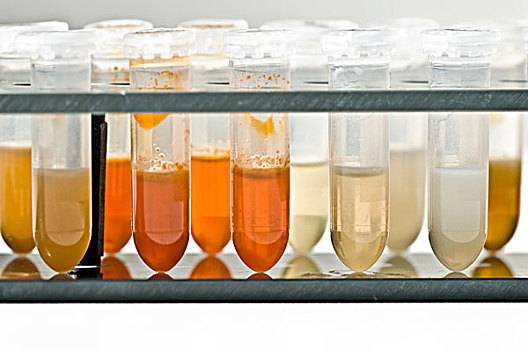
2.2 Enzyme extraction method
The advantages of using enzymes to extract soy protein include high extraction efficiency, mild conditions, no production of toxic substances, and relatively simple operation. The disadvantages are: higher cost than the alkali extraction method, strict requirements for storage and extraction reaction conditions, and the activity being affected by excessive acidity, alkalinity and high temperatures. Li Chuangqian [11] used a domestically produced 1# protease as a hydrolytic enzyme to hydrolyze soybean meal, and studied the change in the protein extraction rate in soybean meal with pH, enzymatic hydrolysis time, liquid-to-solid ratio, and enzyme addition amount. The optimal process conditions for hydrolyzing soybean meal were found, which resulted in a protein extraction rate of 69.41% in soybean meal. Traditional enzymatic hydrolysis is mainly protein-oriented, but studies have shown that the degree of hydrolysis of complex enzymes is higher than that of single enzymes, and the protein extracted by single enzymes has a stronger bitter taste than that extracted by complex enzymes. Li Yang [12] used a complex enzyme hydrolysis method to extract soybean protein, and found that the extraction rate of soybean protein under the optimal process parameters could reach 85.78%. The results showed that the total protein extraction rate after complex enzyme hydrolysis pretreatment was nearly 10% higher than that of the traditional heat and moisture pretreatment.
2.3 Ethanol extraction method
The ethanol extraction method involves repeatedly extracting the raw material, soybeans, with an ethanol solution in a water bath, recovering the solvent from the extract, and obtaining a concentrated protein product. Liang Jianfeng [13] prepared soybean protein concentrate by aqueous ethanol extraction. According to the data from various single factor and orthogonal experiments, the optimal extraction conditions were a solid-liquid ratio of 1:7, an ethanol concentration of 70%, an extraction time of 80 min, and an extraction temperature of 55°C. The protein content measured under these conditions was 73.14% [14].
2.4 Other extraction techniques
include the bipolar membrane method, foam separation method, membrane separation method, ion exchange method, microwave-assisted extraction technology, ultrasound-assisted technology, enzyme-assisted technology, etc.
3 Functional properties of soy protein
Soybeans are one of the most economical and valuable agricultural products due to their unique chemical composition. It has the highest protein content (about 40%) of all cereal and other legume varieties. Soybeans also contain about 20% oil, the second highest content of all edible beans. Other valuable components in soybeans include phospholipids, vitamins and minerals. In addition, soybeans contain many trace substances, some of which, such as trypsin inhibitors, phytates and oligosaccharides, are known to have biological activity. Others, such as isoflavones, are recognized for their powerful ability to prevent human cancers and other diseases [15]. In addition to its extremely high nutritional value, soy protein also has functional properties such as water retention, emulsification, oil absorption, gelling, foaming and binding.
Liu Jun et al. [16] selected five different varieties of soybeans as raw materials and compared and analyzed the effects of raw materials on the yield of soy protein isolate, crude protein content, gel properties, water retention, and emulsifying properties. The processing and functional properties of soy protein isolate from different varieties of soybeans were studied. It was found that soy protein isolate prepared from Jidou 12 as raw material has extremely high water retention, gel properties and excellent emulsifying properties. Jidou 12 is suitable for the production of soy protein isolate with high gel, high water retention and high emulsifying properties.
4 Soy protein peptide
Soy protein is not only rich in a variety of amino acids essential to the human body, but also has a variety of physiological functions after hydrolysis, such as antioxidant, anti-hypertension, anti-cholesterol and other biological functions. Soy protein peptides are mixed oligopeptides prepared by enzymatic hydrolysis, separation, and purification of soy protein. They are usually low molecular weight peptides composed of 3 to 6 amino acids, and their amino acid composition is roughly the same as that of soy protein. They are rich in essential amino acids and balanced [17].
Liu Hui et al. summarized the preparation method, composition, and mechanism of action of the obtained antioxidant soy peptides, indicating the future development direction of antioxidant peptides [18]. It has been proven that using soy protein isolate as a raw material, first enzymolysis with yeast enzymes, and then fermenting with Lactobacillus rhamnosus, the product can be used as a functional food for blood pressure control [19]. Liu Yimei et al. [20] established an animal model, statistically analyzed the experimental results, and studied the anti-cholesterol effect of soy protein peptides. The results showed that soy protein peptides can significantly lower cholesterol, mainly by increasing high-density lipoprotein cholesterol (HDL-C), and have a lowering effect on low-density lipoprotein cholesterol (LDL-C). Studies have shown that soy protein active peptides also have physiological functions such as antibacterial, anticancer, anti-fatigue, anti-radiation, and weight loss.
5 Prospects for the application of soy protein
5.1 Food processing
Because soy protein isolate is rich in various amino acids and some macro- and trace elements, it has attracted much attention in health and nutrition products in recent years. Soy protein isolate can not only improve nutritional value, but also improve the sensory properties of foods. It is widely used in meat products, membrane products, and pasta products in the food processing industry [21].

5.2 New green medical materials
Soy protein isolate is derived from plants, eliminating the risk of disease transmission. Because many traditional tissue engineering materials use toxic solvents and polymers, these solvents and polymers are clearly not environmentally friendly. Scaffolds made from soy protein have suitable mechanical properties, significant biocompatibility and water stability, making them suitable green biomaterials for regenerative medicine applications. Wang Rui Rui [22] summarizes five preparation methods for soy protein isolate-based biomedical materials, analyzes the application prospects of soy protein isolate-based biomaterials in the fields of drug carriers and wound dressings, and finally points out the development direction of soy protein isolate-based biomedical materials.
Jahangirian H et al. [23] not only summarizes other plant proteins (corn, wheat), but also discusses the application of soy protein to create various types of scaffolds for tissue engineering applications. These include porous scaffolds made of soy protein, fibrous scaffolds made of soy protein, and hydrogel scaffolds made of soy protein. The results of various studies are summarized: the addition of SPI changes the microstructure of pure cellulose scaffolds, thereby enhancing mechanical properties, in vivo biocompatibility, and biodegradability; composite films with SPI content higher than 30% have improved mechanical and water resistance properties and suitable biodegradability; HEC-SPI films are biocompatible and show good L929 fibroblast adhesion, proliferation, and differentiation in in vivo studies, making the composite films suitable for medical applications such as tissue regeneration; tofu scaffolds or soy protein scaffolds produced from tofu processing have potential for tissue engineering applications.
Research showed good adhesion, proliferation and differentiation of L929 fibroblasts, making the composite film suitable for tissue regeneration and other medical applications. Tofu scaffolds or soy protein scaffolds produced during tofu processing have potential for tissue engineering applications and are more environmentally friendly than traditional covalent crosslinking methods. Soybeans are suitable as scaffolds for organic skin equivalent culture and as an implant platform for skin regeneration. 3D soy protein scaffolds may be an attractive alternative; the developed composite hydrogel scaffold is a potential biomaterial for bone tissue engineering applications.
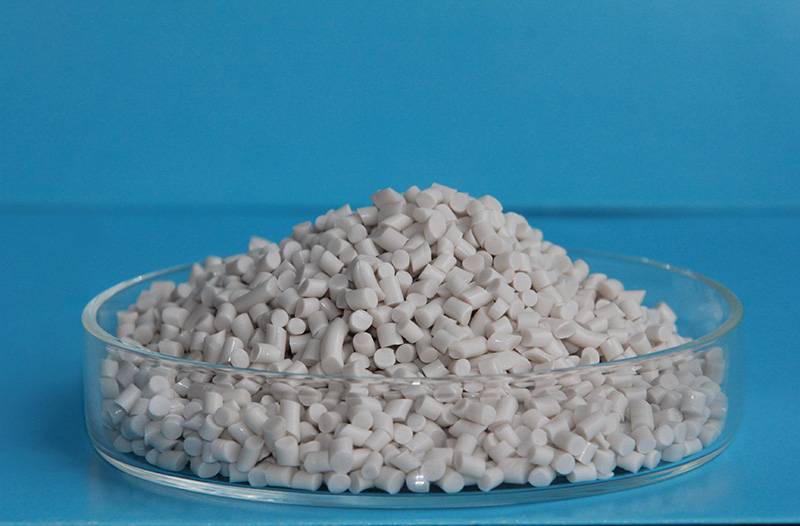
5.3 Other
Yamada M [24] demonstrated the preparation of bioplastics composed of soy protein. The results showed that although soy protein folded in water without a formaldehyde (HCHO) cross-linking reaction, the bioplastics were stable in water. In addition, the flexural strength of the bioplastic increased with the concentration of HCHO, reaching a maximum of about 35 MPa at a concentration of 1% HCHO. Surprisingly, this flexural strength value is the same as that of polyethylene. Finally, they estimated the biodegradability of the bioplastic using a protease. This bioplastic showed a weight loss of about 30% after an incubation time of 6 days. These results indicate that bioplastics consisting of soy protein are biodegradable. Therefore, bioplastics made from soy could be used as biodegradable materials, such as agricultural materials, industrial parts and disposable items.
Chun BH et al. [25] obtained high viral titers by supplementing basic medium with serum-free components, especially those that have been shown to be ideal substitutes for bovine serum. The effect of serum-free medium without animal-derived components on the production of live attenuated varicella virus was evaluated. It was found that the virus yield of the serum-free medium containing soy acid hydrolyzed protein and lipid ultrafiltrate was comparable to that of the medium containing fetal bovine serum.
With the progress of society, people have higher and higher expectations for food and health products, not only for health but also for being green and safe. Soy protein is the highest quality vegetable protein, widely available, inexpensive, and has a nutritional composition similar to, or even superior to, animal protein. Therefore, it is extremely important to develop and utilize soy protein resources, and it is also a hotspot for future development and research.
Reference:
[ 1 ] RosenA,Pyle D L,Nirajan K.Aqueous and enzymatic process⁃ es for edible oil extraction[J].Enzyme & Microb Technol, 1996,19(6):402-420.
[2] Yang Yuexin. China Food Composition Table 2004 [M]. Beijing: Peking University Medical Press, 2004: 77-191.
[3] Jiang Honghua. Nutritional value and health benefits of soybeans [J]. Agricultural Technology and Equipment, 2010 (9): 75.
[4 ] Michelfelder AJ. Soy:a complete source of protein[J]. Am Fam Physician,2009,79( 1):43-47.
[5] The U.S. FDA has approved soy hemoglobin as a coloring agent [J]. Journal of Food and Biotechnology, 2020, 39(1): 92.
[6] Duan J F. Natural polymer materials [M]. Wuhan: Huazhong University of Science and Technology Press, 2016: 283.
[7] Li C F, Zhang Z, Wang C L, et al. Research on the application of soy protein isolate in bread [J]. Soybean Science and Technology, 2020(1): 21-27.
[8] Yongsawatdigul J,Park J W. Effects of alkali and acid solubi⁃ lization on gelation characteristics of rockfish muscle proteins [J]. Journal of food science,2010,69(7):499-505.
[9] Lu Yang, Shi Wenjing, Wang Wenting, et al. Research on the extraction of soy protein isolate and its phytic acid removal [J]. Agricultural Products Processing, 2020 (2): 31-34, 38.
[10] Liu Dong, Liu Rongxu, Wu Xi, et al. Study on the extraction process and quality of fermented soybean meal protein [J]. Food Industry Science and Technology, 2017, 38(12): 214-220.
[11] Chen Chuangqian, Cai Huiwu, Shao Jisheng, et al. Research on the extraction of soybean protein by enzymatic method [J]. Modern Chemical Industry, 2009, 29(S2): 123-124, 126.
[12] Li Yang, Jiang Lianzhou, Sui Xiaonan, et al. Process optimization of soybean protein extraction by composite enzyme hydrolysis [J]. Food Science, 2011(14): 130-133.
[13] Liang Jianfeng, Zhou Xiaowei, Li Hong, et al. Study on the process conditions of alcohol-based extraction of soy protein concentrate [J]. Cereals, Oils and Processing, 2007(10): 87-89.
[14] Li YJ, Liu XF, Liu XM, et al. Process optimization of alcohol-based extraction of soybean protein concentrate [J]. Soybean Science and Technology, 2014 (2): 26-29.
[15] Ciu K. Chemistry and Nutritional Value of Soybean Components [J]. Solybean, 1997.
[16] Liu J, Ma C, Yan L, et al. Effect of soybean raw materials on the processing and functional properties of isolated soy protein [J]. Soybean Science and Technology, 2019 (6): 4-10.
[17] Xiu Liying, Shan Chunjiao, Li Jingjing, et al. Research on the preparation of soybean peptides by enzymatic method [J]. Feed Industry, 2015, 36(18): 44-47.
[18] Liu Hui, Tong Xing. Research progress of antioxidant peptides in soybean hydrolyzed protein [J]. Chinese Condiments, 2021, 46(1): 191-195.
[19] Daliri E B, Ofosu F K, Chelliah R, et al. Development of a Soy Protein Hydrolysate with an Antihypertensive Effect[J]. IntJ Mol Sci. 2019, 20(6): 1496.
[20] Liu Yimei, Chen Zhaohui. Research on the hypolipidemic function of soy protein peptides [J]. Soybean Bulletin, 2004 (3): 22.
[21] Zang Xueli. Application of soy protein isolate in food processing [J]. Food Safety Herald, 2019 (32): 31.
[22] Wang Rui Rui. Analysis of the preparation and application prospects of soybean isolate protein-based biomedical materials [J]. Applied Chemical Industry, 2021, 50(2): 536-541.
[23] Jahangirian H,Azizi S,Rafiee-Moghaddam R,et al. Status of Plant Protein- Based Green Scaffolds for Regenerative Medicine Applications[J]. Biomolecules,2019,9(10):619.
[24 ] Yamada M,Morimitsu S,Hosono E,et al. Preparation of bioplastic using soy protein[J]. Int J Biol Macromol,2020(149):1077-1083.
[25] Chun B H,Yong K L,Bang W G,et al. Use of plant protein hydrolysates for varicella virus production in serum- free medium[J]. Biotechnol Lett,2005,27(4):243-248.


 English
English French
French Spanish
Spanish Russian
Russian Korean
Korean Japanese
Japanese